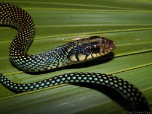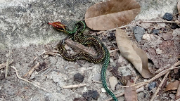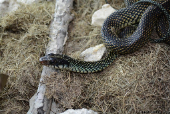Speckled Racer (Drymobius margaritiferus)
Description: The speckled racer is typically black in color with distinctive yellow and blue spotting, one light-colored spot on each scale, which gives the snake an overall greenish hue. The labials are yellow, with black sutures. The underside is typically yellow to green. They average 30 to 40 inches in length, record 50 inches. The dorsal scales, which are feebly keeled middorsally, but smooth on the flanks, are arranged in 17 rows. The ventrals number 142 to 168; the subcaudals, 85 to 126.
Habitat: It occurs in a wide variety of habitats, including forest, forest edges and clearings, secondary growth, riparian zones, savannahs, marshlands, pastures, and roadsides. It is often said to favor humid and wet areas with permanent water sources however, these snakes have been found in areas where no water was apparent and habitats include tropical dry forest and tropical arid forest, In Costa Rica it is described as " ubiquitous in all but the most humid lowland and pre-montane zones" including dry lowland forest.
Range: This species ranges throughout Central America from the Isthmus of Tehuantepec and Yucatan Peninsula southward to Panama and adjacent areas of northwest Colombia, occurring at elevations from sea level up to 4,750 feet. Northward it is found in the coastal lowlands and lower exterior slopes of the Sierra Madres of Mexico, up the west coast to Sonora, and up the east coast to northern Tamaulipas. The northern limit of its distribution ranges into extreme south Texas, USA where it is uncommon to rare in a few of the southernmost counties of the state.
Found in these States:
TX
Diet: They will consume a wide variety of prey, but primarily feed on frogs and toads.
Reproduction: They are oviparous typically laying eggs in the spring, although in southern areas it is known to deposit eggs as early as February and March. Clutch size range from two to eight eggs that are usually 1.5 inches in length. Incubation is typically eight to nine weeks with hatchling measuring six to ten and a half inches long.
Status: The speckled racer is a threatened species in the state of Texas, USA where it is uncommon to rare. In some regions of Mexico and Central America it is a common species.
Subspecies: Four with just one of these found in the United States:
Central American Speckled Racer - (Drymobius margaritiferus fistulosus)
Northern Speckled Racer - (Drymobius margaritiferus margaritiferus)
(Nicaraguan?) Speckled Racer - (Drymobius margaritiferus maydis)
Western Speckled Racer - (Drymobius margaritiferus occidentalis)
»» Kingdom: Animalia - Animals
»» Phylum: Chordata - Chordates
»» Subphylum: Vertebrata - Vertebrates
»» Class: Reptilia - Reptiles
»» Order: Squamata - Scaled Reptiles
»» Suborder: Serpentes
»» Superfamily: Colubroidea
»» Family: Colubridae - Colubrids
»» Genus: Drymobius
»» Species: Drymobius margaritiferus - Speckled Racer
This article uses material from the Wikipedia article "Drymobius margaritiferus", which is released under the Creative Commons Attribution-Share-Alike License 3.0. Content may have been omitted from the original, but no content has been changed or extended.
|













